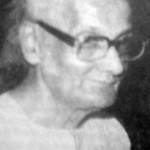|
For several decades he was one of the foremost figure in the nation's academic and intellectual life. Professor Maheswar Neog was a versatile scholar and visionary thinker with encyclopedic range. Arena of his studies covers all disciplines of Indian studies, language and literary history, lexicography and orthography, epigraphy and ethnography, historiography and hagiography, fine arts and paintings, music, dance, drama, religion and folklore apart from critical editions of a number of important ancient and medieval texts in Sanskrit and Assamese.
Simplicity, punctuality, discipline and an untiring belief in his own capacity led him on in the journey of life. Dr Neog began his life as a schoolteacher, crossed all hurdles in spite of financial constraints and won laurels for himself as a profound scholar. The multifaceted genius of Dr Neog did not bloom overnight. His father, who had no formal education was his first teacher.
In the year 1948 he joined Gauhati University as a teacher. Before joining as a reader of Assamese department in Gauhati University he served as deputy director of literary workshop of Santi Niketon under the central govt. in the year 1954. He was Jawaharlal Nehru Professor of Gauhati University from 1966-1978. From 1978-1984 he was Sankardev Professor of Patiala University of Punjab. From 1974-1977 he was Dean of Faculty of Arts of Gauhati University.
Maheswar Neog was known to be the best among the best of modern Assamese intellectual who represent the Nava Vaishnava tradition in most representative style. He wrote his first poem when he was in Class III and it showed his flair for literature. As a researcher he wrote an article on the marriage songs of Assam when he was just a graduate and the same was published in a prestigious research journal, The Indian Review (1939). The prizes he won for proficiency at the end of each annual term drew the attention of the Inspector of Schools to the tall, sprightly lad with a crop of curly hair.
He received Padmashri in the year 1974. He was president of Asom Sahitya Sabha in 1974 and All India Oriental Conference, 23rd session and Fine Arts Department of Aligarh University.
Professor Dr Maheswar Neog brought out Satriya dance from the cloister and oblivion to the larger area as an excellent dance form on par with Bharat Natyam and Kathak. Dr Neog had given the first exposure of Satriya dance in 1958 nationally in a seminar organized by Sangeet Natak Akademi at Vigyan Bhavan in New Delhi.
Professor Dr Maheswar Neog's main contribution to knowledge as he felt himself is in study of and exposition of the cultural history of north-eastern States – its people, language, literature, culture and civilization. During his tenure in Gauhati University (1948-1978) and Punjabi University, Patiala (1978-1983), he had made sustained efforts to bring these obscure aspects of Indian culture to light. Some recognition of his work came when Government of India selected him to be the member of Bharatiya Bhasha Samiti, to visit East European countries on a lecture tour, to act as a member of the Indian National Commission for co-operation with UNESCO. Amongst other thing, Dr Neog was picked up as a member of Bharatiya Jnanpith Award Selection Board which is a noticeable recognition as a discerning literary critic. But according to Dr Neog the best assessment of his work came in the form of valued remark on some of the publications by Professor Dr Suniti Kumar Chatterjee, Prof. Sushin Kumar De, Professor Dr D C Sirkar, Professor K A Nilakanta Singh, Dr Nihar Ranjan Ray. The magnum opus of Dr Neog perhaps is Sankardeva and his Times: Early History of the Vaisnava Faith and Movement in Assam. Another important publication of Dr Neog is Prachya Sasanavali – a study in epigraphs of eastern India for about 600 years was a very valuable edition to Indian epigraphical literature." Other works of Dr Neog were received with similar approbation in scholarly circles and indicates Dr Neog's success in the pursuit of knowledge as a whole.
Dr Maheswar Neog died on 13 September, 1995 |



